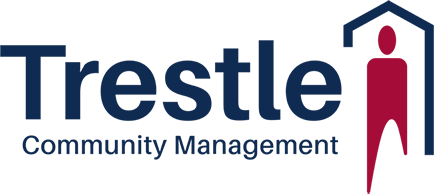Trestle Explains Why Homeowners Pay Assessments
Understanding the role of an Association itself helps Homeowners understand why they pay assessments. Familiarity with the Association’s legal obligations help Homeowners avoid confusion and frustration in working with their Board of Directors and Community Association Management Company.
Community Association Purpose and Creation

Associations serve to create a community for Homeowners. Pooling resources and utilizing centralized maintenance through the Board of Directors and other volunteers, Associations can maintain an appealing aesthetic, create a sense of community, and help Homeowners retain and increase their home values.
In Washington State, Community Associations, also known as Common Interest Ownership Associations, are corporations, often subject to the Washington State Nonprofit Corporation Act (Nonprofit Act). In addition, Associations are incorporated under one of four common interest ownership acts in Washington State. The applicability of each act depends on the date and way in which the Association was incorporated. The four acts are:
- The Homeowners Association Act,
- The Horizontal Properties Regimes Act (Old Act),
- The Condominium Act (New Act), and
- The Washington Uniform Common Interest Ownership Act (WUCIOA).
Previously, an Association could be incorporated under any active Community Association act. However, with the passage of WUCIOA, all new communities incorporated after July 1, 2018, fall under the act.
Association assessments can be confusing, particularly when different Homeowners are charged a different amount. While it may seem that communities of a similar style should pay similar assessments, there are many factors to take into consideration.
Funding the Association
An Association is comprised of the Homeowners within the community, and it is funded by Homeowner assessments. Typically, an Association’s documents expressly state that any home within the community is inherently a member of, and subject to, the Association. As a result, membership in a Community Association is not optional as it is linked to ownership of a home within the community’s boundaries as defined in the governing documents.
In order to perform required maintenance and upkeep of common and limited common spaces as required in the governing documents, the Association must prepare an annual budget outlining anticipated expenses and then assess each Homeowner their portion of the total. Homeowner expense allocation is detailed in the governing documents and used to determine each Homeowner’s financial responsibility. Assessments may be allocated equally among all homes, or they may be adjusted based on square footage, amenities and more.
Most Associations are nonprofit corporations, and as such, budget to bring in exactly what they plan to spend each year. Association assessments are directly linked to the budget. If an Association’s expected annual expenses are $100,000, it must bring in $100,000 of income during the year to cover these costs. Typically, an Association’s sole source of income is Homeowner assessments and as such, the amount paid by Homeowners directly mirrors the expected expenses.
The Role of Governing Documents
Communities are often incorporated at the time of development by the builder, but some are incorporated later down the road, in the case of a rental unit community which is converted to an Association.
Each common interest ownership act in Washington State outlines different responsibilities and protections for the Association and Homeowners. A community’s Articles of Incorporation and Bylaws typically include details outlining to which act an Association is subject. Board Members and Homeowners may review these documents anytime on Trestle’s My-Community Web Portal or contact the Community’s Association Manager for assistance.
Once an Association has been incorporated, responsibility is better defined, which allows the community to prepare its other governing documents. An established Association may have many community-specific governing documents, but each community starts with same core documents:
- Articles of Incorporation – typically document the legal creation of the Association as a corporation,
- Bylaws – often establish the rules which define the innerworkings of the Association, such as Board of Director eligibility, positions, terms, and election processes, and
- Declaration – usually define maintenance responsibility, and outline which elements belong to the Homeowners, and which belong to the Association.
Comparing Assessments Among Communities
Association responsibilities are outlined in each community’s governing documents and while communities may share similarities in amenities and structure, expense responsibilities can vary significantly. If a neighboring community appears similar but Homeowners in one community are responsible for their individual landscaping costs and the expense is covered by the Association in another, assessments will vary.
In addition to recurring maintenance expenses, savings for larger, predictable expense often varies among Associations. Under Washington State Law, most Associations are required to obtain an annual reserve study. A reserve study is a budgeting and planning tool prepared by an independent reserve specialist and used to determine the expected and remaining useful life of common elements. Common elements typically consist of items accessible to or used by a majority of Homeowners and are often maintained by the Association as a common expense. The study also outlines the projected replacement cost of the elements as well as reserve (savings) recommendations and strategies.
In communities where the Association maintains the roads, roofs, siding or other large items, the reserve savings recommendations can be high. These recommendations are in place to allow the Association to save the needed funds over time and avoid delays in maintenance when the items are at the end of their useful life. While some communities opt to save aggressively, others do not. As a result, communities of a similar style may have lower assessments but inadequate reserve savings, which could lead to a future special assessment.
The Role of the Board of Directors
As a corporation, the Association is run by a Board of Directors. Oftentimes, the Board consists of elected members from the community, though some governing documents allow non-Homeowners to run for Board positions. Additionally, communities under development may temporarily have builder representatives on the Board while the community continues to be built.
The Board of Directors’ responsibilities are outlined in the community’s governing documents and often include the administration of the Association. Board Members are tasked with adhering to the Association’s legal requirements outlined in Washington State law and the Association’s governing documents. These requirements include maintenance of elements as defined in the documents. While each community is different, an Association is often responsible for the maintenance of common elements, which are items accessible to most, if not all, Homeowners. This would include items such as a monument sign, playground, lobby, and park.
An Association may also be responsible for the maintenance of limited common elements, which generally include items used by one or more Homeowners and are often visible to the community. Though the Association may have the ability to seek reimbursement from affected Homeowners for these maintenance expenses.
Trestle’s Role in Community Association Management
Trestle is a professional management firm, specializing in Community Association Management. Trestle Community Management is often hired by Boards of Directors to provide advisory services and oversee the day-to-day operations of the Association. However, Trestle may be hired solely to provide bookkeeping services for a community. Trestle’s Team and its Managers are experienced and trained within the community association industry to understand the laws which apply to it Client Associations, and to guide the Board of Directors in making sound decisions which, in turn, protect the property values in the community.
Getting Involved
Interested Homeowners can learn more about their Community Association and its Board by visiting Trestle’s My-Community Web Portal, contacting the Community’s Association Manager and attending Board and community meetings.
Connecting with Trestle
Trestle regularly connects on LinkedIn, Facebook, and Twitter, and can be contacted through its website or at (425) 454-6404.



